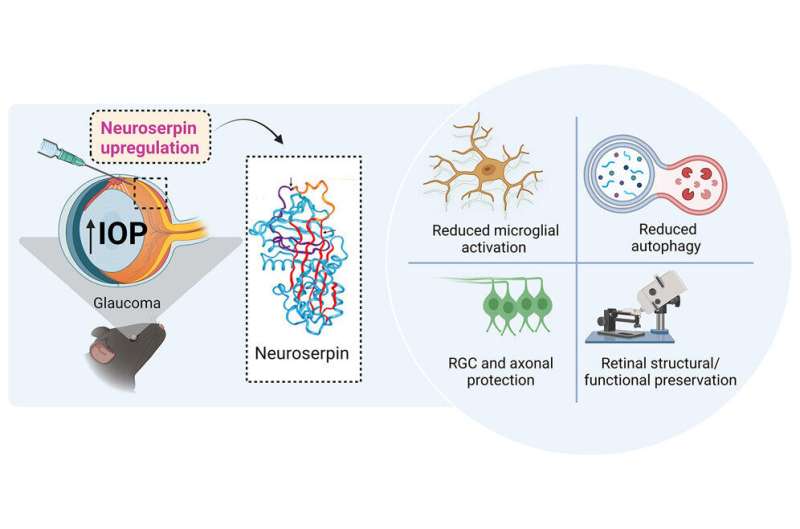This article has been reviewed according to Science X's editorial process and policies. Editors have highlighted the following attributes while ensuring the content's credibility:
fact-checked
peer-reviewed publication
trusted source
proofread
Gene therapy could help treat glaucoma

Macquarie Medical School researchers have developed a technique for a gene therapy that could help treat the world's leading cause of irreversible blindness. The findings are published in the journal Molecular Therapy.
A treatment that ensures nerve cells in the eye continue to produce a vital protein that protects them from being broken down could help prevent the progression of glaucoma, researchers have found.
Glaucoma is the world's leading cause of irreversible blindness, affecting about 300,000 Australians and more than 70 million people globally. It is associated with gradual vison loss, initially in the periphery but then spreading centrally. The disease damages the optic nerve and the retinal ganglion cells, which are a type of neuron that carry visual information to the brain.
Glaucoma is often associated with increased pressure in the eye, and it can be detected during routine vision tests, by measuring the eye pressure or inspecting the optic nerve for damage with special scanners.
While any damage already sustained cannot be reversed, in many cases the progression of the disease can be slowed or stopped through treatment to lower the pressure.
However, many patients continue to worsen despite treatment, indicating there are other factors at play in addition to pressure.
Professor of Ophthalmology Stuart Graham from Macquarie Medical School is leading a team that is investigating the role of the protein neuroserpin in the disease.
Vision Neurobiologist Associate Professor Vivek Gupta says they have found that neuroserpin, which is produced in the connectors between nerve cells, is vital in protecting retinal ganglion cells.
"Other researchers have linked changes in neuroserpin to stroke and neurodegenerative disorders like Alzheimer's and Parkinson's diseases, but our work is the first to relate it to glaucoma," says Professor Gupta.
"Cells naturally break down and are recycled in the body, but when neuroserpin is absent, this process speeds up in the retina.
"Essentially, the body begins to eat away at the retinal ganglion cells and the optic nerve."
Oxidation is a common cause of molecular breakdown in nature. Iron rusting and a cut apple turning brown are both familiar examples.
The team has discovered that when neuroserpin oxidizes, it loses its protective ability, allowing accelerated cell breakdown.
They have also shown that when mice produce more neuroserpin, it has a protective effect, promoting the survival of the retinal ganglion cells and minimizing glaucoma damage.
Vision Scientist Dr. Nitin Chitranshi says in the latest work, detailed in an article in the latest edition of Molecular Therapy, the team has successfully manipulated a gene in mice to produce a version of neuroserpin that is resistant to oxidation.
"When we introduce this gene directly to the eye, it increases the production of neuroserpin in the retina," says Dr. Chitranshi.
"Currently, that involves injecting it into the eye, which is obviously quite confronting, but we are working on a way to introduce the gene using a synthetic virus that can be targeted to specific cells in the retina.
"The artificial virus would not have any effect on the body, but would act as a carrier for the therapy, allowing our specially developed nanoparticles to get inside the cells and tell them to produce our modified neuroserpin.
"We are also working on a way for the protein to give its instructions to produce neuroserpin only to the retinal ganglion cells and not to other neurons, so it can be perfectly targeted."
The team is now preparing for further testing of the enhanced gene and will commence new trials shortly.
Professor Graham says glaucoma is a complex disorder involving a number of mechanisms, not all of which are well understood. "For this reason, our gene therapy is unlikely to be a silver bullet for all glaucoma, but we have great hopes that it will become a valuable part of treatment for use in conjunction with other therapies, making the nerve cells more resistant to damage," he says.
More information: Nitin Chitranshi et al, Neuroserpin gene therapy inhibits retinal ganglion cell apoptosis and promotes functional preservation in glaucoma, Molecular Therapy (2023). DOI: 10.1016/j.ymthe.2023.03.008





















